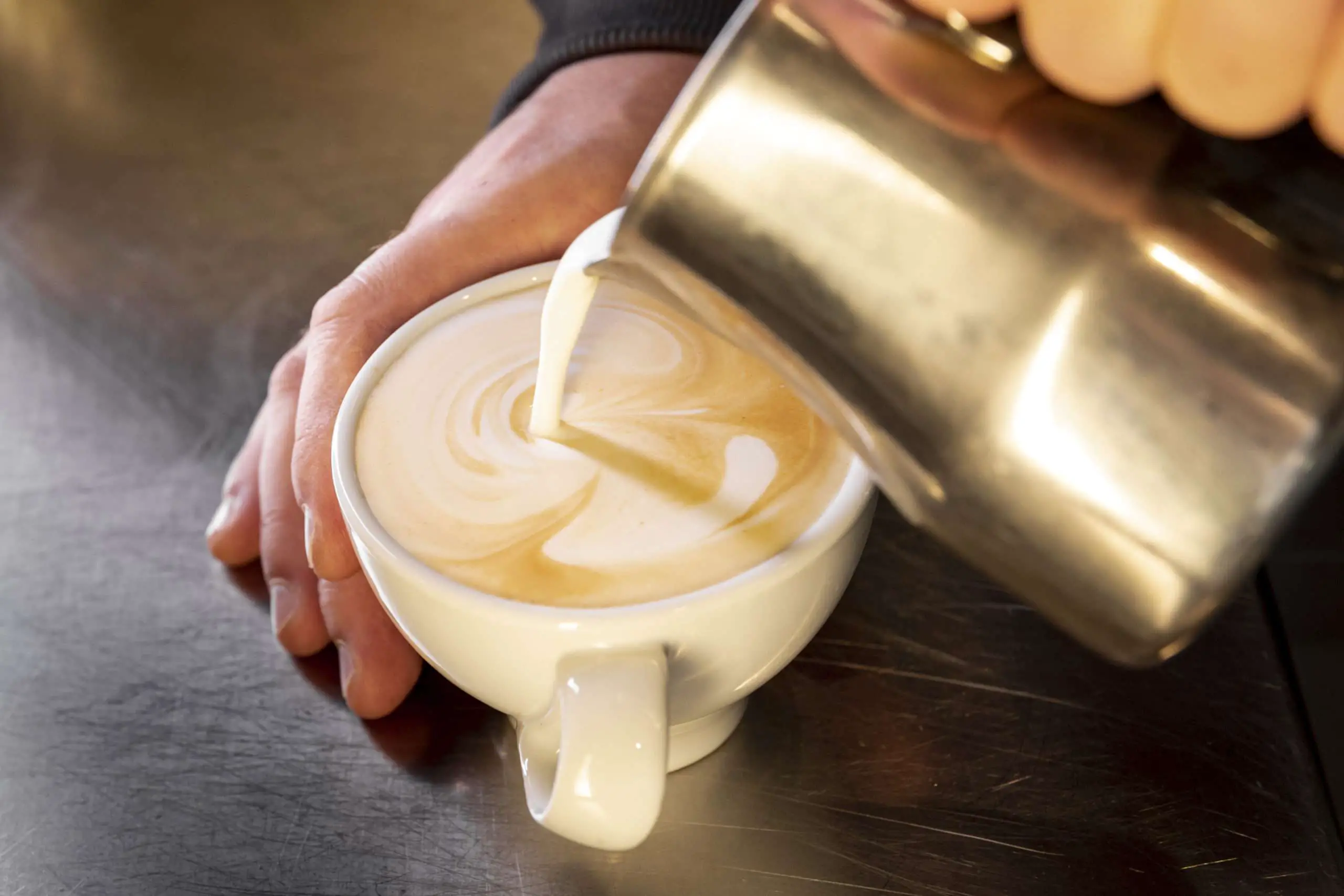How to Choose from Frothed or Steamed Milk: Your Guide to Perfect Coffee Toppings
The choice between frothed and steamed milk can transform your homebrewed coffee. Understanding how to prepare each type enhances flavors and textures that elevate everything from lattes to cappuccinos.
So, how does one choose between frothed and steamed milk? This guide will explore the key differences between the two and provide actionable tips for achieving café-quality foam, bringing your coffee to the next level.
Key Takeaways
- Frothed milk has a light, airy texture perfect for drinks like cappuccinos that need a frothy top layer.
- Steamed milk has a creamier, silkier texture that is ideal for lattes and drinks that need to fold smoothly into espresso shots.
- Frothed milk is made by aerating cold milk with a steam wand to create bubbly foam. Steamed milk is heated with a steam wand to just below boiling to make microfoam.
- Whole milk froths best due to higher fat content. Lower fat milks can also froth but require more technique. Most milks can be steamed.
- Drinks like lattes, flat whites, and mochas tend to use steamed milk. Drinks like cappuccinos and macchiatos tend to use frothed milk.
- Both methods can enhance coffee drinks through taste, texture and visual appeal. Choosing the right preparation is key.
Defining Steamed Milk and Frothed Milk
When exploring the world of coffee beverages, one must distinguish between the textural and temperature variations that steamed and frothed milk offer. The mastery in their preparation can define the quality of a coffee drink.
Steamed Milk Basics
Steamed milk, prepared with a steam wand, is a key component in many espresso-based drinks. The wand introduces steam into the milk, gently heating it to a point where microfoam develops.
These are small, fine air bubbles that create a smooth and velvety texture. Unlike frothed milk, steamed milk has a higher temperature and a creamier consistency, making it ideal for creating lattes and mochas.
Frothed Milk Essentials
Frothed milk is all about aeration, where the steam wand is placed above the milk’s surface to inject large amounts of air.
The result is a layer of thick, stiff milk foam that stands well above the liquid milk. Frothed milk is characterized by larger, more robust air bubbles compared to the silky microfoam of steamed milk.
A cappuccino’s hallmark is a generous top layer of frothed milk, showcasing the beverage’s lively texture.

Key Differences Between Frothed and Steamed Milk
When choosing between frothed and steamed milk for various coffee concoctions, understanding their distinct characteristics is crucial.
Temperature:
- Frothed Milk: Typically starts with cold milk and ends up slightly warmer after aeration, but not as hot as steamed milk.
- Steamed Milk: Heated to a higher temperature, usually between 150°F to 160°F, creating a warm and comforting texture.
- Milk frother makes warm and cold milk froth for cappuccinos, and heats warm milk for lattes. Maximum capacity: 125 ml…
Texture:
- Frothed Milk: Aerated to create a light and voluminous foam, ideal for topping beverages with a thick, creamy layer.
- Steamed Milk: Produces a smoother, silkier feel with minimal foam, known for its microfoam quality that integrates well into the liquid.
Taste:
- Frothed Milk: Can have a slightly cooler taste compared to steamed milk due to its lower temperature.
- Steamed Milk: The heating process may enhance the sugariness of the milk, offering a sweeter flavor profile.
Use in Coffee Drinks:
- Lattes: Usually made with steamed milk, complementing the espresso with a silkier texture.
- Cappuccinos: Depend on a good froth, where frothed milk provides the necessary thick foam layer.
The choice between frothed and steamed milk depends on the desired end result, be it a frothy cappuccino or a smooth, velvety latte. Each has its unique temperature, texture, and taste that can elevate a coffee drinker’s experience.
Making Frothed Milk
To create frothed milk, the appropriate equipment is essential. Most commonly, a milk frother or steam wand is used. The process specifically involves incorporating air into the milk to produce a light and airy foam.
When selecting milk, it’s important to note that not all types froth equally. Lactose-free milk, for instance, still achieves a desirable froth due to the presence of proteins, which are responsible for stabilizing the air bubbles.
Frothing milk relies on incorporating air into the milk to create light, stabilized foam. Follow these steps:
- Start with cold milk straight from the fridge. Whole milk works best. Pour 1 cup of milk into a wide, sturdy pitcher no more than half full to leave room for foam expansion.
- Place the steam wand tip 1-2 inches below the surface of the milk, near the edge of the pitcher. Angle the tip slightly to the side.
- Turn on the steam wand and allow the milk to spin and create a vortex. After 10-15 seconds, slowly lower the tip just below the milk surface. You should hear a light hissing sound.
- Keep the tip in position for another 30-45 seconds as the milk spins. Tiny bubbles will start to form. Monitor the temperature with a thermometer until it reaches 145-155°F.
- Turn off steam just before the pitcher feels hot to touch. The milk should have expanded in volume and look glossy with a smooth, mircfoam texture on top.
- Gently tap the pitcher on the counter to pop any large bubbles before pouring.
No products found.
Advantages of Frothed Milk
Frothed milk lends a sweet, creamy flavor and appealing visual texture to coffee drinks. Some benefits include:
- Enhanced Sweetness: The aeration process gently warms milk, releasing more of its natural sugars to produce a sweeter taste that complements bitterness of espresso.
- Light and Airy Texture: Incorporating tiny air bubbles creates a smooth, silky foam consistency that feels pleasantly soft and foamy on the tongue.
- Beautiful Latte Art Potential: The stabilized microfoam is perfect for pouring intricate latte art designs like ferns and rosettes. The stark color contrast shows up vividly.
- Customization Ability: The thickness and stiffness of frothed milk makes it highly shapeable. Baristas can sculpture it into peaks, swirls, and crests.

Disadvantages of Frothed Milk
However, disadvantages primarily relate to proportion and balance:
- Can Overpower Coffee Flavor: As the froth incorporates air, it dilutes flavors. Too much frothed milk may leave drinks tasting only creamy and sweet rather than showcasing coffee notes.
- Foam Collapses Faster: The delicate bubble structure breaks down more rapidly compared to steamed milk microfoam, especially in hot drinks. This can diminish visual appeal.
- Trickier Pouring and Mixing: Getting smooth consistency requires gently pouring and folding milk into shots rather than stirring to avoid flattening the froth too quickly. Takes some practice.
Making Steamed Milk
To make the perfect steamed milk for a coffee with steamed milk or latte art, one will need to master the use of a milk steamer or steam wand.
Equipment: Positioning the steam wand is crucial. It should be submerged just below the surface of the milk to avoid excessive frothing while still incorporating enough air to create that silky texture.
Technique: When steaming milk, one should aim for a temperature between 150°F and 155°F, which enhances the milk’s natural sweetness. By tilting the steaming pitcher slightly and creating a whirlpool effect, they will achieve a uniform texture necessary for latte art.
Common Mistakes:
- Not purging the steam wand before and after use, which can lead to blockages and contamination.
- Overheating the milk, which can scald it and ruin the flavor.
- Underheating milk may not bring out its sweetness or allow for proper frothing.
Troubleshooting: If the milk isn’t foaming, ensure that the steam wand isn’t too deep in the milk. In case of large bubbles, bring the wand closer to the milk surface to pop them.
- 【4-in-1 Electric Milk Frother】 Easy to operate, one button to heat milk, hot cream foam, cold foam and hot chocolate…
Advantages of Steamed Milk
Properly steaming milk offers notable benefits for coffee drinks:
- Balances Bitterness: The subtle aeration and velvety texture smooths out the robust, intense espresso without overpowering it. Creates a harmonious flavor balance.
- Creamy, Coating Mouthfeel: The microfoam coats the tongue, imparting a lush, silky sensation that accentuates the lush body of the underlying espresso.
- Aids Latte Art: The fine microfoam is easy to pour and allows for etching precise patterns like ferns or rosettes onto the drink surface.
- Easier to Combine: The liquid state and minimal foam enables steamed milk to gently fold into shots rather than sit on top. This properly combines flavors.
Disadvantages of Steamed Milk
The disadvantages relate to flavor and visuals:
- More Neutral Taste: While it complements espresso, steamed milk itself has a subtle flavor that does not add much sweetness or palette complexity on its own.
- Less Dramatic Visuals: With less foam, there is less color contrast against the espresso crema. The texture also appears more uniform.
- Requires More Skill: Achieving the ideal microfoam for stunning latte art requires practice and finesse with the steaming wand to incorporate just the right amount of air.
When to Use Frothed vs Steamed Milk
Choosing between frothed and steamed milk depends largely on the type of coffee beverage being prepared as well as personal taste preferences.
Each method involves different temperatures and techniques suited for specific drinks; cappuccinos typically feature frothed milk, while lattes are known for their steamed milk.
Temperature for Steaming Milk
Steaming milk requires heating the milk with a steam wand to a temperature typically between 150°F to 155°F. This process produces a small amount of microfoam, ideal for integrating smoothly into the texture of a latte.
Steaming milk elevates the sweetness and body of the milk, enhancing the overall taste without overshadowing the espresso.
Temperature for Frothing Milk
Conversely, frothing milk aims to create a light, airy foam, which involves not only heating the milk but incorporating a significant volume of air.
The ideal temperature when frothing should be slightly lower, around 140°F to 155°F, to generate an ample amount of stable foam perfect for topping off a cappuccino.
The volume of the milk will increase as it is aerated, resulting in the characteristic frothy layer that cappuccino lovers relish.
The choice between frothing and steaming is also guided by a person’s taste and the texture they desire in their coffee.

Tips for Frothing and Steaming Milk at Home
Transform your kitchen into a coffee haven with these tips for frothing and steaming milk at home:
Frothing Frenzy:
- Milk Matters: Choose whole milk for the thickest, most stable foam. Skim and plant-based milks require more practice, but experimenting is half the fun!
- Chill Out: Start with cold milk (around 40°F) for optimal frothing. Warm milk creates larger, less stable bubbles.
- Wand Work: If using a steam wand, dip the tip just below the milk’s surface and angle it slightly towards the pitcher. Move the wand in a circular motion, incorporating air as you go.
- French Press Frolic: No fancy equipment? No problem! Fill your French press halfway with milk and plunge vigorously for about 30 seconds. Voilà, instant froth!
- Handheld Hustle: Handheld frothers are convenient but need extra attention. Heat the milk slightly beforehand and pulse the frother in short bursts to avoid burning.
Steaming Serenity:
- Temperature Control: Aim for a final temperature between 140°F and 150°F for a balanced, creamy texture. Overheating can burn the milk and affect the coffee’s taste.
- Whirlpool Wonders: Create a vortex in the milk with the steam wand to evenly distribute heat and prevent scorching. Start closer to the surface and gradually lower the wand as the milk heats.
- Microwave Magic: In a pinch, microwave the milk in short bursts, stopping to stir and check the temperature. Be careful not to overheat or it will curdle.
- Stovetop Serenity: Gently heat the milk on the stovetop, stirring constantly to prevent burning. Use a thermometer to monitor the temperature and stop just before it reaches boiling point.
Bonus Tips:
- Use a clean, cold pitcher for optimal frothing and steaming.
- Practice makes perfect! Don’t be discouraged if your first attempts aren’t latte art masterpieces.
- Have fun and experiment with different milks and techniques to find your perfect coffee companion.
How do I steam milk without a fancy machine?
No fancy machine? No problem! You can still achieve deliciously steamed milk at home with a little ingenuity. Here are three methods:
1. Stovetop Steaming:
- Equipment: You’ll need a small saucepan, a thermometer (optional), and a whisk.
- Method:
- Heat a few inches of milk in the saucepan over medium heat. Don’t let it boil!
- Use the thermometer to monitor the temperature, aiming for 140°F – 150°F.
- As the milk warms, whisk vigorously to create a gentle swirling motion and incorporate air.
- Once you reach the desired temperature, remove from heat and continue whisking for a few seconds to thicken the texture.
2. Microwave Steaming:
- Equipment: You’ll need a microwave-safe jar with a lid.
- Method:
- Pour milk into the jar, filling it no more than halfway to prevent overflow.
- Screw on the lid tightly and microwave on high for 30-45 seconds.
- Remove the jar, taking care as it will be hot! Shake vigorously for about 30 seconds to create foam.
- Unscrew the lid slightly and microwave for another 10-15 seconds to stabilize the foam.
3. French Press Steaming:
- Equipment: You’ll need a clean French press.
- Method:
- Pour lukewarm milk into the French press, filling it about one-third full.
- Plunge vigorously for 30-45 seconds, creating a vortex and incorporating air.
- Stop when the milk becomes warm and slightly frothy.
Tips for All Methods:
- Use cold milk for best results.
- Experiment with different whisking techniques and heating times to find your ideal texture.
- Be careful not to overheat the milk, as it can curdle.
- Enjoy your creamy steamed milk in your favorite coffee beverage!
With a little practice, you’ll be steaming milk like a pro, even without fancy equipment. Remember, it’s all about creating that gentle swirl and incorporating air for a smooth, velvety texture.

Tips and Tricks:
When choosing between frothed and steamed milk for coffee, understanding the techniques and equipment needed for each method is crucial.
Frothing Milk:
A key technique for frothing milk involves the use of a steam wand, which should be plunged into the milk and held just below the surface to create the perfect swirl.
The barista swirls the wand to incorporate air, creating a light, voluminous froth ideal for drinks like cappuccinos and lattes.
The ideal pitcher for frothing is usually made of stainless steel with a narrowing spout, which helps in creating a smooth texture. It is also essential to start with fresh, cold milk as it froths better due to its temperature and freshness.
Equipment for Frothing:
- Stainless steel pitcher
- Fresh, cold milk
Steaming Milk:
For steamed milk, the technique is more subtle and focuses on gently heating the milk while creating a silky microfoam.
The barista should aim to create a vortex in the milk by correctly positioning the steam wand, which helps achieve an evenly heated and aerated milk.
Maintaining the right temperature is crucial to avoid scalding the milk and achieving the desired velvety texture.
Equipment for Steaming:
- Proper steam wand positioning
- Appropriately sized pitcher
Complex beverages require precision, and choosing the right method for frothing or steaming milk can enhance the coffee experience.
Baristas usually recommend that enthusiasts experiment with different techniques and equipment to find their preferred texture and temperature for milk-based coffee drinks.
Drinks Beyond Coffee
While coffee may be a popular choice for incorporating frothed or steamed milk, there are a variety of other beverages that benefit from these milk techniques.
Frothy Cold Drinks
For those who prefer their drinks chilled, frothed milk can transform a simple iced drink into a luxurious treat.
Cold frothy drinks often include iced chocolate or cold lattes, where milk is frothed cold to maintain a creamy top layer without the heat. For example:
- Iced Chai Latte: Frothed cold milk adds a velvety texture that complements the spices.
- Iced Mocha: Incorporating frothed milk can create a light, bubbly contrast to the rich chocolate.
Non-Coffee Hot Beverages
When it comes to hot beverages beyond coffee, both frothed and steamed milk can elevate the drinking experience. Steamed milk is particularly beloved in:
- Hot Chocolate: The steam wand warms the milk while creating a slight foam, making the drink creamier without overpowering the chocolate.
- Matcha Latte: Steamed milk pairs well with the earthy tones of matcha, providing warmth and a smooth texture.
Each drink benefits from the textural enhancements that frothed or steamed milk provide, enhancing the overall sensory enjoyment of the beverage.
FAQs
What are the differences between steamed and frothed milk?
Steamed milk is heated and lightly aerated, resulting in a creamy consistency with a small amount of fine microfoam. In contrast, frothed milk is more heavily aerated to create a large volume of froth with a light and airy texture.
Which type of milk is best for frothing/steaming?
Frothing:
Whole milk: Champion! Its natural fat content creates thick, stable foam, ideal for latte art and rich cappuccinos.
2% milk: Good balance, froths well with slightly less richness than whole milk.
Skim milk: Requires more skill but can still work for airy cappuccinos, larger bubbles less stable.
Steaming:
Whole milk: Creamy and rich, balances coffee without diluting it.
2% milk: Lighter option, good for those who want a creamy texture but prefer less fat.
Skim milk: Subtler texture, works well for lattes with minimal foam.
Is there a taste difference between frothed and steamed milk in coffee drinks?
The taste of milk in coffee drinks may not significantly change between frothed and steamed, but the textural difference can affect perception. While steamed milk is smoother and more velvety, frothed milk offers a light and airy mouthfeel.
What kinds of milk beverages typically require the use of steamed milk?
Latte, flat white, and mocha are some examples of coffee drinks that typically make use of steamed milk due to its silky texture and ability to meld with espresso while still allowing for latte art.
Can you achieve frothed milk using a steam wand, and if so, how?
A steam wand can indeed be used to froth milk by positioning it near the surface to introduce air and create foam before then fully submerging it to continue heating the milk.
In terms of texture and temperature, how does steamed milk compare to frothed milk?
Steamed milk is smoother and warmer, with a uniform, velvety texture, while frothed milk is cooler due to the air incorporated into it and exhibits a more substantial, fluffy foam.
What if my milk doesn’t froth/steam properly?
Frothing woes:
Large bubbles: You’re incorporating too much air. Try a slower, more circular motion with the wand or frother, and focus on submerging the tip for smooth microfoam.
Thin, flimsy foam: Your milk might be too warm. Start colder (around 40°F) and avoid overheating during frothing.
Not frothing at all: Check the fat content. Whole milk froths best, while skim milk requires more skill. Consider trying a different type of milk or adding a teaspoon of sugar for increased stability.
Wand placement: Ensure the steam wand tip is just below the milk’s surface and slightly angled towards the pitcher. Move it in a circular motion to incorporate air evenly.
Steaming snags:
Scorching: If your milk starts burning, stop immediately. Adjust the steam wand position and steam less aggressively. A thermometer can help monitor the temperature, aiming for 140°F – 150°F.
Flat, milky texture: You might not be incorporating enough air. Create a gentle vortex in the milk with the wand, starting closer to the surface and gradually lowering it as the milk heats.
Curdling: This can happen with high heat or acidic milk. Use cold milk and avoid overheating. Some alternative milks are more prone to curdling, so adjust your technique or try a different type.
Bonus tips:
Always use a clean pitcher or jar for optimal frothing and steaming.
Practice makes perfect! Don’t be discouraged if your first attempts aren’t masterpieces.
Experiment with different techniques and milk types to find your sweet spot.
Remember, the key is to be patient, adjust your technique, and have fun! With these tips and a little practice, you’ll be frothing and steaming like a pro in no time.









